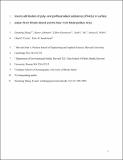| dc.contributor.author | Zhang, Xianming | |
| dc.contributor.author | Lohmann, Rainer | |
| dc.contributor.author | Dassuncao, Clifton | |
| dc.contributor.author | Hu, Cindy | |
| dc.contributor.author | Weber, Andrea Kristina | |
| dc.contributor.author | Vecitis, Chad D. | |
| dc.contributor.author | Sunderland, Elynor M | |
| dc.date.accessioned | 2017-01-30T19:43:18Z | |
| dc.date.issued | 2016 | |
| dc.identifier | Quick submit: 2017-01-26T12:17:16-0500 | |
| dc.identifier.citation | Zhang, Xianming, Rainer Lohmann, Clifton Dassuncao, Xindi C. Hu, Andrea K. Weber, Chad D. Vecitis, and Elsie M. Sunderland. 2016. “Source Attribution of Poly- and Perfluoroalkyl Substances (PFASs) in Surface Waters from Rhode Island and the New York Metropolitan Area.” Environmental Science & Technology Letters 3 (9) (September 13): 316–321. doi:10.1021/acs.estlett.6b00255. | en_US |
| dc.identifier.issn | 2328-8930 | en_US |
| dc.identifier.uri | http://nrs.harvard.edu/urn-3:HUL.InstRepos:30168293 | |
| dc.description.abstract | Exposure to poly- and perfluoroalkyl substances (PFASs) has been associated with adverse health effects in humans and wildlife. Understanding pollution sources is essential for environmental regulation, but source attribution for PFASs has been confounded by limited information about industrial releases and rapid changes in chemical production. Here we use principal component analysis (PCA), hierarchical clustering, and geospatial analysis to understand source contributions to 14 PFASs measured across 37 sites in the northeastern United States in 2014. PFASs are significantly elevated in urban areas compared to rural sites except for perfluorobutanesulfonate, N-methyl perfluorooctanesulfonamidoacetic acid, perfluoroundecanate, and perfluorododecanate. The highest PFAS concentrations across sites were those of perfluorooctanate (PFOA, 56 ng L−1) and perfluorohexanesulfonate (PFHxS, 43 ng L−1), and perfluorooctanesulfonate (PFOS) levels are lower than earlier measurements of U.S. surface waters. PCA and cluster analysis indicate three main statistical groupings of PFASs. Geospatial analysis of watersheds reveals the first component/cluster originates from a mixture of contemporary point sources such as airports and textile mills. Atmospheric sources from the waste sector are consistent with the second component, and the metal smelting industry plausibly explains the third component. We find this source-attribution technique is effective for better understanding PFAS sources in urban areas. | en_US |
| dc.description.sponsorship | Engineering and Applied Sciences | en_US |
| dc.language.iso | en_US | en_US |
| dc.publisher | American Chemical Society (ACS) | en_US |
| dc.relation.isversionof | doi:10.1021/acs.estlett.6b00255 | en_US |
| dash.license | OAP | |
| dc.title | Source Attribution of Poly- and Perfluoroalkyl Substances (PFASs) in Surface Waters from Rhode Island and the New York Metropolitan Area | en_US |
| dc.type | Journal Article | en_US |
| dc.date.updated | 2017-01-26T17:17:15Z | |
| dc.description.version | Accepted Manuscript | en_US |
| dc.relation.journal | Environmental Science & Technology Letters | en_US |
| dash.depositing.author | Vecitis, Chad D. | |
| dc.date.available | 2016 | |
| dc.date.available | 2017-01-30T19:43:18Z | |
| dc.identifier.doi | 10.1021/acs.estlett.6b00255 | * |
| dash.contributor.affiliated | Tokranov, Andrea | |
| dash.contributor.affiliated | Hu, Cindy | |
| dash.contributor.affiliated | Vecitis, Chad | |
| dash.contributor.affiliated | Zhang, Xianming | |
| dash.contributor.affiliated | Sunderland, Elynor | |


